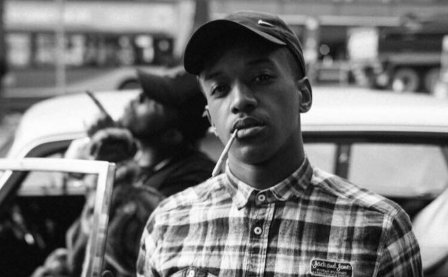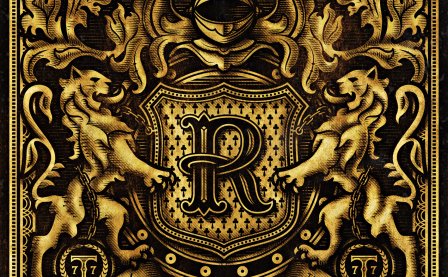The-Dream exists among his peers in an oddly singular liminal state, betwixt and between obscurity, celebritydom, and apotheosis. During the past few years, he has written some of our biggest pop hits (Rihanna’s “Umbrella,” Beyonce’s “Single Ladies (Put A Ring On It),” Mariah Carey’s “Tough My Body”), released a very highly acclaimed R&B album (Love Hate), and been christened as one of our generation’s greatest pop artists, yet the next time you see him on TMZ or the cover of Rolling Stone will be the first. So, what is it? Is The-Dream a “radio killa” (read: pop star), an “R&B guerilla” (read: someone less ubiquitous), or a tortured genius (read: an unappreciated artist during his time)? On second full-length Love vs. Money, he wants it all: to have love and money, respect and popularity -- that is, to be timeless and timely.
At the heart of The-Dream’s sweaty and galactic jams is a cornucopia of the 21st-century’s distinguishing pop templates. There are a myriad of chopped and screwed and auto-tuned vocals, hints of Timbo-styled soft percussion clicks and hiccups, and the increasingly prevalent gang chant (listen: Pollow Da Don’s discography). But, even more vital to the general pop flavorings are the countless repeated vocals. For instance, the ad nauseam “yeahs” on “Mr. Yeah,” which certainly have a thematic meaning (Mr. Yeah is a “yes-man” to a comical degree), are extremely catchy, not unlike Rihanna’s “ella, ella, eh, eh, eh”s on “Umbrella.” Here, we hear a crack in the sonic text, The-Dream’s pop formula exposed.
Of course, it is impossible to speak of The-Dream, or his formula, without mentioning Christopher "Tricky" Stewart, who produces eight of the album’s tracks. Together, these two have teamed to create the most fascinating, if not finest, pop hits of recent times. A string of Billboard successes predicated on simplicity: The-Dream’s hiccupping vocal tics and Tricky’s looping whirring, heavy synths followed by ringing percussion accents. A formula that has become the formula, our formula, the epitome of pop, truly nothing could be more fundamentally timely.
But, on Love vs. Money, this formula is continually being played with. In fact, all of these previously mentioned pop templates are at play, and thereby deconstructed, a fascinating and at-times sonically remarkable post-structuralist-esque move. Take, the astonishing “Fancy/Right Side Of My Brain” suite, on which fanciful piano chords, dreamy vocals, and dawdling beatboxing are positioned next to cacophonous gang chants and hard-chopped and screwed vocals. Here, conventions are torn down: formula and novelty, the expected and unexpected -- disparate genres are conflated. These are the makings of novelty, the critical grist for the mill of artistic timelessness.
Along the same lines, The-Dream’s touchstones are indicative of his desire for timelessness. There are the themes that inspirit every track: love, sex, and money, which are certainly timeless (and/or timely), if not a bit tired, even banal. Certainly, the homogeneity of all the sex-talk (come-ons and pick-up lines galore) is the album’s lone glaring weakness, but with frequent gems, like “Now if they ask you can I sing like Usher, say no/ But I can make you sing like Mariah, ooooooooh,” it is nearly impossible to be too mad.
Then, there are the featured artists. In contrast to Love/Hate, superstars Fabolous, Rihanna, and Prince have been replaced with legends Kanye West, Mariah Carey, Michael Jackson, and R. Kelly. On “Walkin’ On The Moon,” for instance, The-Dream pays homage to the king of pop while the nouveau riche of rap (read: Kanye) spits 16-bars. Then, on the album’s final track, “Kelly’s 12-Play,” R&B star R. Kelly, arguably the major influence for The-Dream’s sexed-up, machismo-laced, colossal-loverboy shtick ("I'm all up on you like a monster truck"), is referenced, but, notably, where The-Dream begins by singing “Now we doin’ it to Kelly’s 12-Play,” he ends the track and the album with “Now we doin’ it to Dream’s Love/Hate.” In a move reminiscent of the Romantic poet, The-Dream apotheosizes himself, lifting himself up among the “stars” that he referenced earlier; thus, he is Kelly’s successor, the new R&B god, an artist of the timeless variety.
If this album teaches us anything about The-Dream, he's aiming for legendary status, deftly maneuvering between being relevant and progressive. He gives us a ubiquitous pop formula, only to deconstruct it, leaving the album with many striking and singular tracks. Yet there are no sure-fire uber-#1-hit, the likes of which he has created, with seeming ease, for so many other artists. As a result, Love vs. Money exists, much like its creator, stuck somewhere between timely and timeless, kind of like a dream, the infectious, can’t-get-out-of-your-head variety.
1. Money Intro
2. Rockin’ That Shit
3. Walkin’ On The Moon featuring Kanye West
4. My Love featuring Mariah Carey
5. Put It Down
6. Sweat It Out
7. Take U Home 2 My Mama
8. Love vs. Money
9. Love vs. Money: Part 2
10. Fancy
11. Right Side Of My Brain
12. Mr. Yeah
13. Kelly’s 12 Play
14. Let Me See The Booty featuring Lil Jon (Bonus Track)
More about: The-Dream




